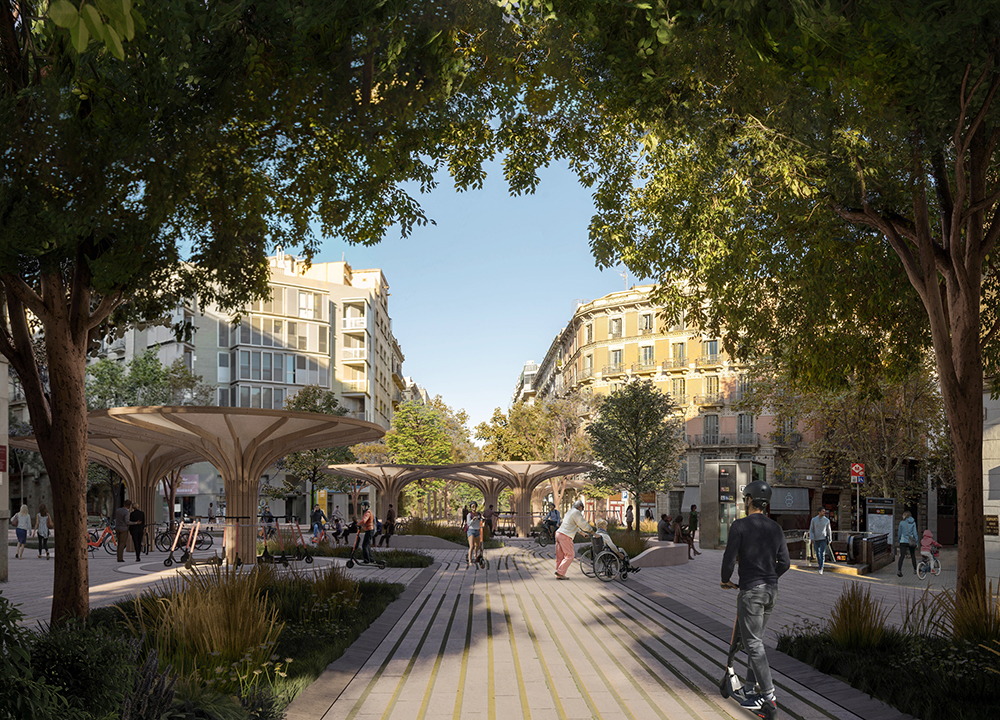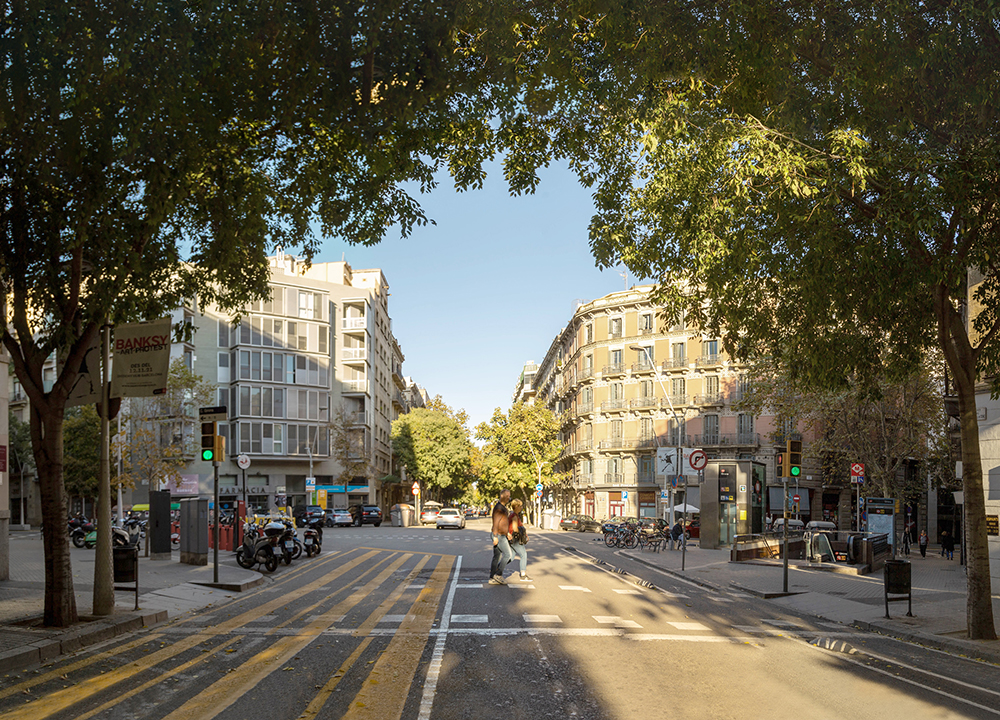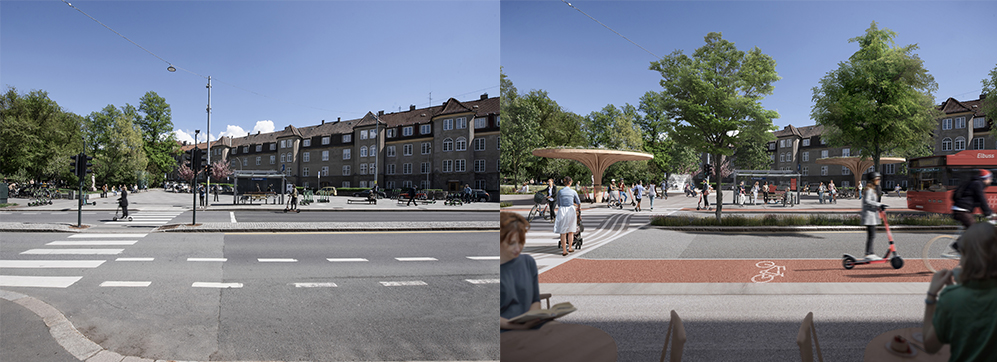
In so many respects cars make cities worse places. They hog public space (50% in European cities), they produce much of the air pollution that plagues 96% of Europe’s urban population, and are involved in 80% of fatal bike and e-scooter crashes.

The scope for motorists to use other modes is enormous given that cars on average move 1.3 passengers and more than half of car journeys cover distances of less than 5km.
Despite this, car use in Europe remains deeply entrenched. The convenience and utility of the privately-owned car is powerful and mass transit isn’t easy to improve further in cities with mature bus and rail networks.
It’s clear that new thinking is needed, which a new report attempts to offer.
Backcasting to the future
Called Cities Made for Living, and co-authored by micromobility specialist Voi and Danish architecture practice JaJa, it envisions a future of multimodal streetscapes across European cities from Marseille, France, to Liverpool, UK. It paints a picture of what these cities could be like to live and move around in if planners had a free hand to optimise cities for people rather than cars.
JaJa developed this vision by ‘back-casting’, rather than planning based on extrapolating existing trends into the future.
JaJa’s head of mobility, Robert Martin, an Australian-born but Copenhagen-based green mobility advocate, says the new possibilities that this approach offers could unlock transformative change.
Backcasting enables planners to create optimal mobility mixes for livable, prosperous, equitable and sustainable cities – rather than responding to the demands of mobility forecasts based on existing, car-centric paradigms.
It could overcome the hurdles urban planners had always faced before when trying to reduce the reliance on cars for mobility, says Martin: “This decoupling of the car is a paradigm shift for me. Sharing platforms enables you to tailor the vehicle to the type of journey.”
This approach enables planners to maximise the potential of shared and micromobility to enhance and support other transit options by offering new journey permutations and by stitching disparate journey solutions more harmoniously together.
E-scooters offer a choice for short first- and last-mile journeys, bikes for longer ones, cargo bikes for small logistics. A car sometimes is the only feasible choice, for instance, in an emergency or when travelling with cargo but this can be enabled by car sharing. By providing access to alternative modes of transport, shared mobility systems thus enable citizens to choose the most suitable transport mode – or a combination of modes – for a specific trip.

Filling in the gaps
Shared micromobility, in particular, can help address traditional public transport’s first- and last-mile problem. Combining a bus and a scooter can reduce hurdles and total travel time, making public transport a viable alternative to the car for both city dwellers and populations living outside city centres for whom mass transit combined with micromobility could connect different areas.
E-scooter provider Voi claims that 47% of its riders combine e-scooters with public transport. Voi insists this is cutting car use, with 16.3% of its trips replacing car journeys in 2021.
The transformative potential of this approach is already apparent in the more than 20 large continuous car-free zones in city centres in European cities now showing the way.
In Stuttgart, integrating shared micromobility into the local public transport system saw rides with shared e-scooters rise by 250%, and contributed to a 35% increase in train ticket sales.
Car-free city centres and pedestrian streets (either temporary or permanent) have also been shown to increase commercial activity on high streets in different towns and cities across Europe.
Local shopping increased by 30% after a large area in central London implemented increased traffic restrictions. There was a 60% increase in visits to a shopping street in Berlin after it closed down car traffic and opened it for pedestrians and cyclists.
Meanwhile, 90% of Stockholmers believed that closing select streets to cars in the summer has made the streets a place where people want to stay and socialise and rendered the streets safer and more attractive.

Executing on the vision
This menu of mobility options that make possible the transformation was not on offer until recently and digitisation is its key enabler. The maturity of the necessary technologies - cheap, ubiquitous smart phones, Internet of Things (IoT)-enabled devices and GPS are the three central ones - creates the conditions for the smart mobility platforms that enable Mobility as a Service (MaaS) business models.
They promise a seamless way to book a combined trip with many modes of transportation in a one-stop shop and could ultimately even enable the user to search and pay for a route door-to-door, including a combination of transit and micro vehicle modes.
Of course, one size does not fit all and the broad approach needs to be adapted to suit different cities or different urban settings within the same city, with different conditions. “We try to nuance the conversation bit. There are different types of spaces that constitute a city. Residential streets should have very different attributes to a transport corridor, for example,” says Martin.
“For residential streets it’s about creating connections between the people that live there and creating enjoyable space. Transport corridors are about throughput, adding micromobility to link up with public transport while adding qualities like ample space for things like ground-level food shops and biodiversity.”
While the vision is strong, the battle is far from won yet. Much thinking in city planning circles is still muddled. Half-hearted pilots involving autonomous vehicles still too often represent misconceived urban mobility approaches and taking away city parking remains a policy minefield through which mayors and municipalities must tiptoe.
Even in bike-friendly paragon Copenhagen, car ownership has actually increased in the last 20 years, and it currently imposes heavy restrictions on shared micromobility operators, making it difficult for them to function, notes Martin.

Convincing decision-makers
An important means of convincing decision-makers is being able to demonstrate that, with the right execution, local residents can become supporters of change as they see the benefits when temporary schemes are trialled. “People used to driving into the city all day start to look for alternatives. It is not until we change that perspective that they realise it is possible to do it in another way,” says Martin.
This is an especially important requirement for change since mayors are typically closely connected to local communities from whom good feedback matters. Success also requires engaging multiple city departments since local plans need to dovetail across residential, transport and other areas.
Successful approaches also need to be adaptable and apply user feedback as part of the adjustment process, Martin adds.
A pilot in Copenhagen, for example that employed 70% less parking space but built in space for trees and micromobility parking worked well.
Residents liked the free bike share and access to cargo bikes, car share and discounted public transport. But the scheme also identified room for improvement. Residents didn’t like using too many apps to manage these options, for example.
It’s not yet clear what the answer is here. Will city authorities develop one app to rule them all, or let the market decide? “We will probably see some integration across modes, but they are still figuring out how these systems work,” predicts Martin.
Another evolving area is the logistics of shared and micromobility, which remains immature, he adds: “A lot of shared micromobility companies are still figuring out that they are operations as well as tech companies. They need warehouses and they need to master the logistics of moving their products around cities.”
Important details will need to be established. Where do the bicycle logistics hubs go in expensive prime real estate city centres? Can scooters be left anywhere or are they better parked at hubs and, if so, how widely spaced should the hubs be?
While the answers to these challenges will differ by city and by street block, the contribution that micro and shared mobility solutions can make to greener cities, cleaner air - and more vibrant, equitable neighbourhoods - is clear.












